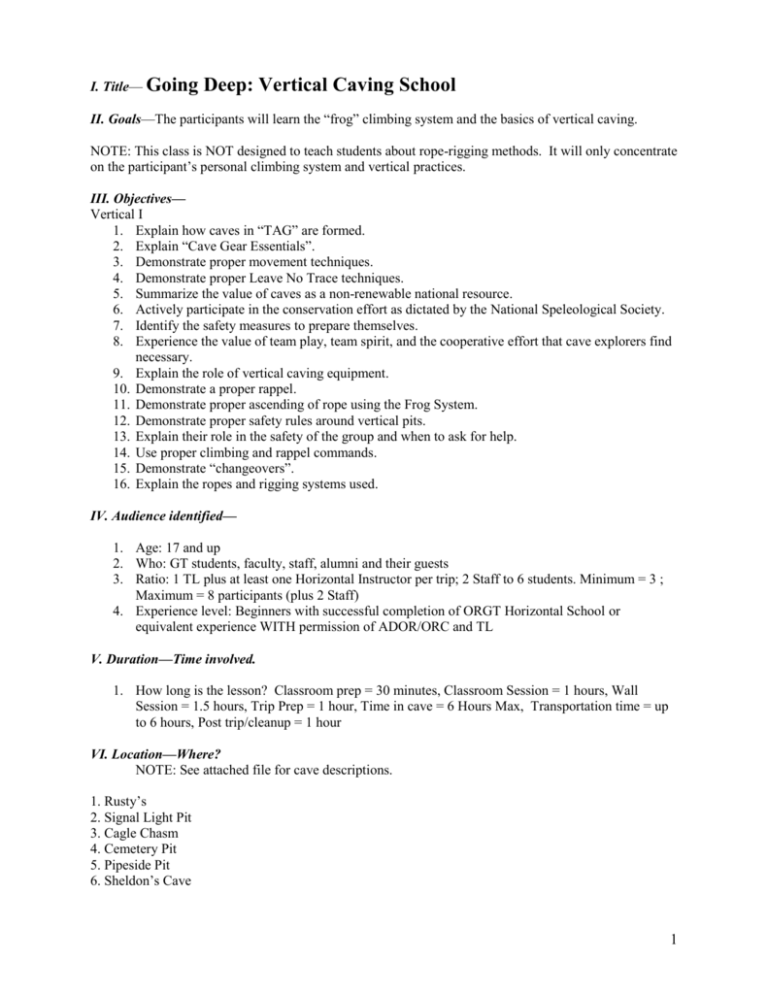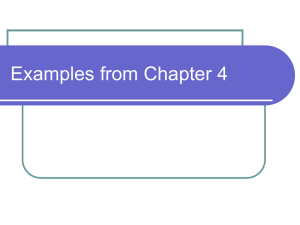Vertical I
advertisement

I. Title— Going Deep: Vertical Caving School II. Goals—The participants will learn the “frog” climbing system and the basics of vertical caving. NOTE: This class is NOT designed to teach students about rope-rigging methods. It will only concentrate on the participant’s personal climbing system and vertical practices. III. Objectives— Vertical I 1. Explain how caves in “TAG” are formed. 2. Explain “Cave Gear Essentials”. 3. Demonstrate proper movement techniques. 4. Demonstrate proper Leave No Trace techniques. 5. Summarize the value of caves as a non-renewable national resource. 6. Actively participate in the conservation effort as dictated by the National Speleological Society. 7. Identify the safety measures to prepare themselves. 8. Experience the value of team play, team spirit, and the cooperative effort that cave explorers find necessary. 9. Explain the role of vertical caving equipment. 10. Demonstrate a proper rappel. 11. Demonstrate proper ascending of rope using the Frog System. 12. Demonstrate proper safety rules around vertical pits. 13. Explain their role in the safety of the group and when to ask for help. 14. Use proper climbing and rappel commands. 15. Demonstrate “changeovers”. 16. Explain the ropes and rigging systems used. IV. Audience identified— 1. Age: 17 and up 2. Who: GT students, faculty, staff, alumni and their guests 3. Ratio: 1 TL plus at least one Horizontal Instructor per trip; 2 Staff to 6 students. Minimum = 3 ; Maximum = 8 participants (plus 2 Staff) 4. Experience level: Beginners with successful completion of ORGT Horizontal School or equivalent experience WITH permission of ADOR/ORC and TL V. Duration—Time involved. 1. How long is the lesson? Classroom prep = 30 minutes, Classroom Session = 1 hours, Wall Session = 1.5 hours, Trip Prep = 1 hour, Time in cave = 6 Hours Max, Transportation time = up to 6 hours, Post trip/cleanup = 1 hour VI. Location—Where? NOTE: See attached file for cave descriptions. 1. Rusty’s 2. Signal Light Pit 3. Cagle Chasm 4. Cemetery Pit 5. Pipeside Pit 6. Sheldon’s Cave 1 How will you get there? a) CRC Vehicle ( Preferred ) b) Self drive with carpool NO GT insurance coverage in private vehicles Should travel in caravan as a group Know vehicle info and have phone numbers in each vehicle Land access / permits/ private property Follow all registration and land access guidelines. VII. Content & Methods— Classroom I. Intro 1. Personal Introductions and Name Game a. Welcome everyone b. Ask a useful short question—What do you hope to get our of the class? Caving experience? You can use other ideas that are appropriate. c. Remember to cycle back so that everyone begins to bond by knowing each others names d. Double check class attendance with sign-up. If folks aren’t registered make arrangements for this to occur prior to trip 2. Introduce Class and ORGT a. Advertise other classes and trip b. ORGT / Caving progression: Participant ->Instructor->TL (keep it REALLY simple) c. Rules: i. Inherently dangerous – Accept risks of the trip ii. No mind-benders (alcohol or drugs) prior to outing or on outing. No smoking due to fire risk and annoyance iii. Because of complex logistics be on time iv. Weather: 1) Meeting morning of to decide 2) Be prepared for it 3. Tell participants about the opportunity they will have to disclose pertinent medical history at the end of class session if TL is present; if TL is not present they let them know they will be given the TL’s contact info and should feel free to contact with any questions or concerns. Say “The reason you should tell the TL about this pertinent past medical history is not to get medical clearance or advice to go, that happens between you and your doctor. The reason is: 1) to help us in the case we need to make or change plans that day 2) to help us help you get your medication if you need it 3) to help us take better care of you and the group” 4. Hand out the “Intro to Vertical Caving Class Notes” (if appropriate) This class is held a few days before the first vertical caving trip, and is required for all participants. It is designed to teach the most basic information a caver needs to know before he or she attempts to visit a vertical cave, and to let the Trip Leader and Instructors see how the participants perform while on rope in a controlled environment. 2 II. The Parts and Pieces 1. Caving Rope a. Explain differences between rock climbing and caving – in rock climbing, the rope is there as a safety device. In caving we climb the rope itself. b. Caving rope is nylon static rope – doesn’t stretch as much as dynamic rope. 11mm or 7/16” in diameter, it will hold about 4000 lbs. when brand new. c. Static rope is very strong, but still susceptible to being cut – no need to have knives or any other sharp objects around the rope. Do not step on the rope if at all possible. Do not run it over sharp edges. Keep it away from all chemicals. d. Think of it as your lifeline, because it really is. 2. Ascenders a. Petzl handled ascenders, just a brand name. b. Blue is right-handed, gold is left-handed. Designed to be opened and closed with one hand. c. Ascenders are used to clamp onto the rope and move in one direction – a one-way ratcheting system. <Instructors should stretch a piece of rope out and allow students to practice attaching/unattaching ascenders> d. The ascenders are used to inchworm our way up the rope, though we can stop and rest at any time. e. They are designed to only move one direction, though you can make them go down the rope with practice <demonstrate how>. 3. Seat harness a. Very simple and rugged design, which is good for caving b. Adjustable waist loop and leg loops. Straps should be very snug, but not super-tight. c. All buckles MUST be doubled-back. If you see the word DANGER, you’re not done yet. d. The D-ring is the central attachment for everything, so it must be placed correctly. e. The D-ring screw gate should close from wearer’s right to left, so that moving rope will screw it shut when climbing. f. Side accessory loops are not that strong, not life-supporting. 4. Croll and Chest Harness a. Like an ascender, but without the handle. b. Attaches directly to D-ring. c. There’s a right way and a wrong way – the croll should rest flat against your belly. d. We have two different styles of chest harnesses – taller torsos should use the “serpentine” version. e. When ready to climb, chest harness should be so tight it’s hard to stand up straight. 5. Upper Ascender and Cows Tail a. Usually right-handed, this will be tethered to the D-ring by the cows tail. b. Length of long cows tail: when the upper ascender is attached with a carabiner, the tether c. Should allow the user to grip the ascender by the handle with their arm straight out in front at shoulder height. d. Slightly too short is better than slightly too long. e. Length of short cows tail: with your elbow at the D-ring, the carabiner should be in the palm of your hand. f. Account for slight stretch if using dynamic rope. g. We use locking carabiners, so we are confident they won’t come undone/open. h. Foot loop – not life supporting, so it’s made of lighter cord, attached to upper ascender. i. Length of foot loop: standing with both feet in the foot loop, the upper ascender should reach a few inches above the croll. 3 6. Safety Ascender a. Two ascenders would be enough to climb rope, but we life to be extra “safe”, hence the third “safety”. b. Length of tether should be the same as the upper ascender. c. Usually left-handed, since the right hand will be busy as a brake hand when rappelling. d. Order of attachment on D-Ring, user’s right to left: croll, cows tail, safety 7. Carabiners a. We normally use locking “D”-shaped carabiners, which have a screw gate that locks the carabiner shut. b. Carabiners are very strong when pulled lengthwise, not as strong when crossloaded or loaded against the gate. c. Carabiners can be used for simple gear-storage loops on the side or back of the harness, which is the ONLY time they don’t need to be locked. d. Easily lost – keep track of your carabiners! 8. Rappel Rack a. The “Cadillac” of rappelling devices – bulky but very versatile. b. 6 bars, each bar adds more friction. c. The bars can slide up and down the rack -- move them together for tighter bends and more friction (slower), or apart for less friction (faster). d. Bars can be removed. Less bars spread farther apart means less friction. e. NEVER USE LESS THAN FOUR BARS! f. When rappelling, this is our only attachment to the rope. g. We use two locking carabiners, opposite and opposed. h. The rappel rack should be oriented with the opening to the right and the top rope groove facing towards the user. i. The rack should be attached between the spine of the croll and the cows tail. 9. Rappel Rack Operation <An instructor should demonstrate all the details below> a. Brake hand (usually right hand) is always on the rope. Rope can slide through, but brake should always be ready to squeeze rope. b. Brake hand should be near user’s waist, not right next to the rappel rack (to prevent gloves being sucked into rack) c. Left hand should be used to control speed, by manipulating the bars up and down. d. Left hand can also be used to push off walls or ledges, it’s free to move around. e. Safety should be left dangling loose when rappelling, for easy access f. Avoid getting hair or loose clothing stuck in rappel rack. g. If that happens, stop IMMEDIATELY and attach safety as tightly as possible. h. Soft Locking off the rack – add all bars, push them up as tightly as possible. Wrap the rope below the bottom bar, then up and over the notch between the top of the rack and the rope. This is a soft lock-off, which can come undone by itself. So it’s NOT hands-free, your brake had must stay on the rope! i. Hard lock-off: From soft lock-off position, feed a loop of rope through the eyelet at the base of the rack. Pull enough slack through to tie an overhand knot in this loop, above the rappel rack. If the safety is left on the rope when beginning to rappel, it will be pulled tight and can be difficult to remove from the rope. III. Rope Commands It may be hard to communicate. So every caver is trained to listen for and use these “rope commands”. 4 “On Rope” – means “I want to use this rope, so nobody else should touch it”. Yell this BEFORE attaching to the rope. Wait for an “Okay” from the other end (whether rappelling or climbing). If you don’t hear Okay, yell On Rope again. “Off Rope” – means “I am finished with the rope, and it is safe for the next person to use”. Wait for an “Okay”. Do not yell this until you are completely detached from the rope, and away from the lip (or out of the rock-fall zone at bottom). “On Belay” – means “I am ready to rappel, please prepare to stop me if needed”. Wait for “Belay On” from the bottom belayer. A bottom belay is achieved by a person pulling strongly downward on the rope below the rappeller, which causes the rappel rack to slow or stop. “Rock!” – means “Something is falling down the pit”. Yell if it’s a rock, a carabiner, a helmet, anything. It does NOT mean look up to see what’s coming down – you should move out of the way of any objects that the rappeller might knock down (known as the rock-fall zone). “No!” – means stop what you are attempting to do (ie. do NOT get on rope, do not attempt to rappel, etc.) 10. Say: “It is important for you to disclose pertinent medical history with the Trip Leader because we make many decisions throughout the trip, and, knowing this information may help us take better care of you and of the group. If you have questions about your past medical history, and whether you should go or not, we recommend that you contact your doctor and give them a thorough description of the intensity of the course as we have disclosed here and get their permission to go on the trip. Most of our classes are very physically demanding, so the decision should be made between you and your doctor. Contact the Trip Leader if you have more questions about the contents of the course, the physical demands of the trip, or to disclose any pertinent medical information that will help us take better care of the you and the group.” 11. WRITE TRIP LEADER’S CONTACT INFORMATION OF BOARD AND ANNOUCE TO ALL PARTICIPANTS IV. At the Wall/Platform 1. Notes for Instructors a. Helmets should be worn by all participants. b. All of the participant’s climbing and rappelling equipment should be in place and ready to use, regardless of which direction they are traveling on the rope. c. Explain the dimensions of the rock fall zone. d. Explain what the lip of the pit is, and how to maneuver an ascender past the lip. e. At least one vertical instructor should be located at top of platform, and one at bottom AT ALL TIMES. f. Explain multiple ropes, ie. “On Rope 1”, “Off Rope 2”, etc. g. Demonstrate how to properly frog up the rope. Emphasize equipment safety check, rope commands as well as proper body posture when climbing. Point out how much tighter the chest harness needs to be when climbing. Demonstrate how to switch from two feet to one foot and back, and why it’s often easier to climb with one foot when against a wall, or when crossing the lip. Explain where both hands should go when climbing, to minimize effort. Demonstrate how to properly rappel, and how to safely lock off the rack. 5 2. Notes for Students a. Equipment check – make sure all harness buckles are doubled back, and carabiners are locked (including long cows tail carabiner) b. Yell “On Rope” before getting on a rope. Wait for an “Okay” from the platform above. c. Attach the croll to rope first, then the upper frog ascender (this order helps keep the tethers organized). d. Now unattach all your ascenders again, practicing what it will take to get unattached at the top of the platform. e. Re-attach the croll and upper ascender, and pull all the slack out of the rope. f. Sit down, and tighten up chest harness about as tight as it will go. g. Place both feet in the footloop, with the main rope in front of the loop and between your feet. h. Raise your hands and feet at the same time (this sometimes feels very weird for a beginner), keeping your feet back underneath your bottom and your body as vertical as possible. i. Stand up so the croll slides up the rope, making sure the rope is gripped between your feet. <The instructor can also pull gently down on the rope, to make sure it moves through the croll correctly>. Note that the thumb cam on the upper ascender does NOT need to be opened to move the ascender up the rope – all you have to do is push up with the handle. j. The left hand usually rests on the shell of the upper ascender, right above the right-handed handle. k. Repeat the climbing cycle until you are against the wall. l. If desired, try removing one foot from the footloop and climbing with just one foot to see the difference. m. At the lip, move your feet up the wall so that you can push away and slide your upper ascender over the top. Everyone has their own method for this maneuver, so experiment a little bit. n. Once on the platform, the instructor will show where to attach your safety, o. Remove the croll from the rope first (which makes it much easier to move around), then the upper ascender. p. Make sure the rope is clear and resting smoothly on the pad at the lip, then yell “Off Rope”. q. When ready to rappel, attach the rappel rack to your D-ring, and make sure all biners and Drings and buckles are still locked. r. Have the instructor check all of your equipment. s. Yell “On Rope”. Wait for an “Okay”. t. Your safety should be on the rope you are about to rappel. Attach your rappel rack an inch or two below the safety. u. Use all 6 bars, as a too slow rappel is much better than too fast! v. Normally the rope will be running on the right side of your legs, in line with your right brake hand. w. Perform a soft lock-off of the rappel rack, then slowly lean back and weight the rappel rack. NOTE: From this point on, your brake hand should ALWAYS be on the rope. x. The instructor should ask you to recite the methods of controlling speed on a rappel rack: adding removing bars, pushing bars tighter together, and squeezing with the brake hand. y. Yell “On Belay”. Wait for a “Belay On” response. z. If all seems well, remove the safety (leaving it hanging free in case of need). Then with all bars pushed up as tight as they will go, undo the soft lock on the rappel rack. aa. As you move over the edge of the lip, keep your feet spread a foot or two apart, making a little tripod. This will prevent you from falling to either side. bb. Walk down the wall, moving each foot down one at a time. Using your knees is okay, though flat on your belly is not. cc. Remember to lean back a little, so hair and clothes does not get caught in the rappel rack. dd. Your feet should never be higher than your waist. ee. Practice using your left hand to move the bars up and down, adjusting your speed. The brake hand should be used as a safety device only. 6 ff. If anything goes wrong, place your safety on the rope above the rappel rack. It may get pulled tight and may be difficult to remove, but it’s there to be used in an emergency! gg. Rappel down at a smooth rate. If you are continually struggling to slide down the rope, carefully remove the bottom bar from your rack. Remember that the rope will become much faster when you do this. hh. On the floor, remove all equipment from the rope, and step out of the rock fall zone. ii. Yell “Off Rope” and wait for an “Okay”. II. At some point in the curriculum include the following: 1. Discuss the effect of weather in safe caving 2. Debriefing, tell them When and Where to expect this 4. Leave No Trace reminder Before Leaving ORGT 1. TL should have a private meeting with each participant following ORGTs Medical Information Gathering Policy. If the TL met with participants at pre-trip meeting, they need to still meet w/them the day of the trip asking “has anything changed since our last meeting, any medications today or new injuries that you are concerned about”. This meeting is confidential. 2. Say sincerely “______ is inherently dangerous; we need you to know that everything you do today is completely voluntary. If you feel uncomfortable with what you are doing, please notify the Trip Leader or Instructor, and they will do whatever they can to take you out of that situation. ORGT operates under the ‘challenge by choice’ philosophy which means that you can stop anytime and you challenge yourself using your own guidelines. If you want to stop, give us the word, and we’ll give you our support”. 3. 4. 5. 6. 7. 8. 9. 10. Photo-copy emergency contacts Check waivers and forms Check weather/trail closures Check and load Group gear Check and load Personal gear Name Game Confirm everyone’s gear is loaded Get/give contact info from/to drivers VIII. What is a foul weather alternative? – IX. Evaluation—Assessing learning. 1. School Evaluation sent by email from ORGT Admin using “surveymonkey.com” Strongly encourage them to take this. It will be “open” for only 3 days. This survey helps legitimate ORGT as a valuable program here at GT, also helps us get better at what we do. “Please fill it out so we can continue to offer these great programs” Includes: Evaluation of learning objectives from above TL and Instruction Evaluation General evaluation of processes 7 2. Make a general statement about receiving emails from ORGT regarding other classes, trips, schools, special events and tell them they need to come tell you if they want to opt out, otherwise they can opt out once they receive the first email. X. Follow up—What’s next? XV. Reference materials to support your lesson 1. The National Spelological Society “Caving Basics”. 2. “On Rope” by Allen Padgett and Bruce Smith 3. European counterpart, “Alpine Caving Techniques 4. “Vertical”, by Australian caver Alan Warild. 8








